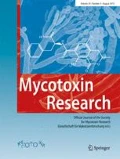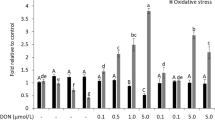Abstract
This work studied the effect of deoxynivalenol (DON) and two of its acetylated analogs (3-ADON, 15-ADON) on first indicators of oxidative stress status, namely production of reactive oxygen species (ROS) and induction of lipid peroxidation (LPO), in HepG2 cells. HepG2 cells were exposed to different concentrations of the three toxins, either alone or in combinations, for 24, 48, and 72 h. Results of cytotoxicity obtained in HepG2 cells were correlated with the detection of ROS and LPO. This effect was inversely correlated with ROS while directly correlated with LPO for the assayed mycotoxins in individual treatment. Combinations of two toxins containing 15-ADON yielded highest values, while for two-toxin combinations with 3-ADON, the effects were minor. A combination of all three mycotoxins alleviated ROS production and the highest levels in LPO were detected, in association to a final breakdown of adaption of ROS early produced by HepG2. In conclusion, parameters of stress evaluation presented in this study (ROS and LPO), revealed increases in HepG2 cells exposed to DON, 3-ADON, and 15-ADON either individually or combined.




Similar content being viewed by others
References
Alassane-Kpembi I, Puel O, Oswald IP (2015) Toxicological interactions between the mycotoxins deoxynivalenol, nivalenol and their acetylated derivatives in intestinal epithelial cells. Arch Toxicol 89:1337–1346
Bensassi F, El Golli-Bennour E, Abid-Essefi S, Bouaziz C, Hajlaoui MR, Bacha H (2009) Pathway of deoxynivalenol-induced apoptosis in human colon carcinoma cells. Toxicology 264:104–109
Bryła M, Waskiewicz A, Ksieniewicz-Wozniak E, Szymczyk K, Jedrzejczak R (2018) Modified fusarium mycotoxins in cereals and their products—metabolism, occurrence, and toxicity: an updated review. Molecules 23:963. https://doi.org/10.3390/molecules23040963
Buege JA, Aust SD (1978) Microsomal lipid peroxidation. Methods Enzymol 52:302–310
Cano-Sancho G, Gonzalez-Arias CA, Ramos AJ, Sanchis V, Fernandez-Cruz ML (2015) Cytotoxicity of the mycotoxins deoxynivalenol and ochratoxin a on Caco-2 cell line in presence of resveratrol. Toxicol in Vitro 29:1639–1646
Casteel M, Nielsen C, Didier A, Dietrich R, Märtlbauer E (2010) Induction of MAPK dependent transcription factors by deoxynivalenol in human cell lines. Mycotoxin Res 26:9–14
Chou T-CH (2006) Theoretical basis, experimental design, and computerized simulation of synergism and antagonism in drug combination studies. Pharmacol Rev 58:621–681
Chou T-CH, Talalay P (1984) Quantitative analysis of dose–effect relationships: the combined effects of multiple drugs or enzyme inhibitors. Adv Enzym Regul 22:27–55
Costa S, Schwaiger S, Cervellati R, Stuppner H, Speronia E, Guerra MC (2009) In vitro evaluation of the chemoprotective action mechanisms of leontopodic acid against aflatoxin B1 and deoxynivalenolinduced cell damage. J Appl Toxicol 29:7–14
Dinu D, Bodea GO, Ceapa CD, Munteanu MC, Roming FI, Serban AI, Hermenean A, Costache M, Zarnescu O, Dinischiotu A (2011) Adapted response of the antioxidant defense system to oxidative stress induced by deoxynivalenol in Hek-293 cells. Toxicon 57:1023–1032
EFSA (2017) Risks to human and animal health related to the presence of deoxynivalenol and its acetylated and modified forms in food and feed. Scientific Opinion. EFSA J 15(9):4718–4345
Fernández-Blanco C, Font G, Ruiz MJ (2014) Oxidative stress of alternariol in Caco-2 cells. Toxicol Lett 229:458–464
Ferrer E, Juan-García A, Font G, Ruiz MJ (2009) Reactive oxygen species induced by beauvericin, patulin and zearalenone in CHO-K1 cells. Toxicol in Vitro 23:1504–1509
Halbin KJ, Serge M, Kouakou B, Dago G (2003) Inula crithmoides extract protects against ochratoxin A-induced oxidative stress, clastrogenic and mutagenic alterations in male rats. Int J Sci Technol Res 2:2277–8616
Janssen EM, Liu C, Van der Fels-Klerx HJ (2018) Fusarium infection and trichothecenes in barley and its comparison with wheat. World Mycotoxin J 11(1):33–46
JECFA (2010) Evaluation of certain contaminants in food. Seventy-second report of the joint FAO/WHO expert committee on food additives. WHO technical report series 959, p 100. http://ir.uv.es/2yTH7vn. Accessed Jan 2019
Juan C, Ritieni A, Mañes J (2012) Determination of trichothecenes and zearalenones in grain cereal, flour and bread by liquid chromatography tandem mass spectrometry. Food Chem 134:2389–2397
Juan C, Berrada H, Mañes J, Oueslati S (2017) Multi-mycotoxin determination in barley and derived products from Tunisia and estimation of their dietary intake. Food Chem Toxicol 103:148–156
Juan-García A, Juan C, König S, Ruiz MJ (2015) Cytotoxic effects and degradation products of three mycotoxins: alternariol, 3-acetyl-deoxynivalenol and 15-acetyl-deoxynivalenol in liver hepatocellular carcinoma cells. Toxicol Lett 235:8–16
Juan-García A, Juan C, Manyes L, Ruiz MJ (2016) Binary and tertiary combination of alternariol, 3-acetyl-deoxynivalenol and 15-acetyl-deoxynivalenol on HepG2 cells: toxic effects and evaluation of degradation products. Toxicol in Vitro 34:264–273
Kalaiselvi P, Krishnaswamy R, Bharathi PL, Padma VV (2013) Cytoprotective effect of epigallocatechin-3-gallate against deoxynivalenol-induced toxicity through anti-oxidative and anti-inflammatory mechanisms in HT-29 cells. Food Chem Toxicol 56:110–118
Klaric MS, Papeljnjak S, Domijan AM, Petrik J (2006) Lipid peroxidation and glutathione levels in porcine kidney PK15 cells after individual and combined treatment with fumonisin B1, beauvericin and ochratoxin a. Basic Clin Pharmacol Toxicol 100:157–164
Kouadio JH, Dano SD, Moukha S, Mobio TA, Creppy EE (2007) Effects of combinations of fusarium mycotoxins on the inhibition of macromolecular synthesis, malondialdehyde levels, DNA methylation and fragmentation, and viability in Caco-2 cells. Toxicon 49:306–317
Krishnaswamy R, Devaraj SN, Padma VV (2010) Lutein protects HT-29 cells against deoxynivalenol-induced oxidative stress and apoptosis: prevention of NF-κB nuclear localization and down regulation of NF-κB and cyclo-oxygenase – 2 expressions. Free Radic Biol Med 49:50–60
Maresca M (2013) From the gut to the brain: journey and pathophysiological effects of the food-associated trichothecene mycotoxin deoxynivalenol. Toxins 5:784–820
Mary VS, Arias SL, Otaiza SN, Velez PA, Rubinstein HR, Theumer MG (2017) The aflatoxin B1-fumonisin B1 toxicity in BRL-3A hepatocytes is associated to induction of cytochrome P450 activity and arachidonic acid metabolism. Environ Toxicol 32:1711–1724
Pestka JJ (2008) Mechanisms of deoxynivalenol-induced gene expression and apoptosis. Food Addit Contam Part A Chem Anal Control Expo Risk Assess 25:1128–1140
Pestka JJ, Zhou HR, Moon Y, Chung YJ (2004) Cellular and molecular mechanisms for immune modulation by deoxynivalenol and other trichothecenes: unraveling a paradox. Toxicol Lett 153(1):61–73
Pinton P, Tsybulskyy D, Lucioli J, Laffitte J, Callu P, Lyazhri F, Grosjean F, Bracarense AP, Kolf-Clauw M, Oswald IP (2012) Toxicity of deoxynivalenol and its acetylated derivatives on the intestine: differential effects on morphology, barrier function, tight junction proteins, and mitogen-activated protein kinases. Toxicol Sci 130(1):180–190
Prosperini A, Juan-García A, Font G, Ruiz MJ (2013a) Reactive oxygen species involvement in apoptosis and mitochondrial damage in Caco-2 cells induced by enniatins a, A1, B and B1. Toxicol Lett 222:36–44
Prosperini A, Juan-García A, Font G, Ruiz MJ (2013b) Beauvericin-induced cytotoxicity via ROS production and mitochondrial damage in Caco-2 cells. Toxicol Lett 222:204–211
Prosperini A, Font G, Ruiz MJ (2014) Interaction effects of fusarium enniatins (a A1, B and B1) combinations on in vitro cytotoxicity of Caco-2. Toxicol in Vitro 28:88–94
Ramyaa P, Padma VV (2013) Ochratoxin-induced toxicity, oxidative stress and apoptosis ameliorated by quercetin – modulation by Nrf2. Food Chem Toxicol 62:205–216
Ramyaa P, Krishnasamy R, Padma VV (2014) Quercetin modulates OTA-induced oxidative stress and redox signaling in HepG2 cells—up regulation of Nrf2 expression and downregulation of NF-jB and COX-2. Biochim Biophys Acta 1840:681–692
Shah L, Ali A, Yahya M, Zhu Y, Wang S, Si H, Rahman H, Ma C (2018) Integrated control of fusarium head blight and deoxynivalenol mycotoxin in wheat. Plant Pathol 67:532–548
Siegel D, Babuscio T (2011) Mycotoxin management in the European cereal trading sector. Food Control 22(8):1145–1153
Stanciu O, Juan C, Miere D, Loghin F, Mañes J (2017) Occurrence and co-occurrence of fusarium mycotoxins in wheat grains and wheat flour from Romania. Food Control 73:147–155
Strasser A, Carra M, Ghareeb K, Awad W, Bohm J (2013) Protective effects of antioxidants n deoxynivalenol-induced damage in murine lymphoma cells. Mycotoxin Res 29:203–208
Sugiyama K, Kinoshita M, Kamata Y, Minai Y, Tani F, Sugita-Konishi Y (2012) Thioredoxin-1 contributes to protection against DON-induced oxidative damage in HepG2 cells. Mycotoxin Res 28:163–168
Tiessen C, Fehr M, Schwarz C, Baechler S, Domnanich K, Böttler U, Pahlke G, Marko D (2013) Modulation of the cellular redox status by the alternaria toxins alternariol and alternariol monomethyl ether. Toxicol Lett 216:23–30
Vidal A, Sanchis V, Ramos AJ, Marín S (2016) The fate of deoxynivalenol through wheat processing to food products. Curr Opin Food Sci 11:34–39
Yang W, Yu M, Fu J, Bao W, Wang D, Hao L, Yao P, Nüssler AK, Yan H, Liu L (2014) Deoxynivalenol induced oxidative stress and genotoxicity in human peripheral blood lymphocytes. Food Chem Toxicol 64:383–396
Yang YYS, Tan Y, Liu N, Wu A (2017) Individual and combined cytotoxic effects of co-occurring deoxynivalenol family mycotoxins on human gastric epithelial cells. Toxins 9:96
Zhang X, Jiang L, Geng C, Cao J, Zhong L (2009) The role of oxidative stress in deoxynivalenol-induced DNA damage in HepG2 cells. Toxicon 54:513–518
Zhou H, George S, Hay C, Lee J, Qian H, Sun X (2017a) Individual and combined effects of aflatoxin B1, deoxynivalenol and zearalenone on HepG2 and RAW 264.7 cell lines. Food Chem Toxicol 103:18–27
Zhou H, George S, Li C, Gurusamy S, Sun X, Gong Z, Qian H (2017b) Combined toxicity of prevalent mycotoxins studied in fish cell line and zebrafish larvae revealed that type of interactions is dose-dependent. Aquatic Toxicol 193:60–71
Acknowledgements
Authors would like to thank Spanish Ministry of Economy and Competitiveness for the funding received to perform this study.
Funding
This work has been funded by the Spanish Ministry of Economy and Competitiveness (grant number: AGL2016-77610-R).
Author information
Authors and Affiliations
Corresponding author
Ethics declarations
Conflict of interest
None.
Additional information
Publisher’s Note
Springer Nature remains neutral with regard to jurisdictional claims in published maps and institutional affiliations.
Rights and permissions
About this article
Cite this article
Juan-García, A., Juan, C., Tolosa, J. et al. Effects of deoxynivalenol, 3-acetyl-deoxynivalenol and 15-acetyl-deoxynivalenol on parameters associated with oxidative stress in HepG2 cells. Mycotoxin Res 35, 197–205 (2019). https://doi.org/10.1007/s12550-019-00344-0
Received:
Revised:
Accepted:
Published:
Issue Date:
DOI: https://doi.org/10.1007/s12550-019-00344-0




